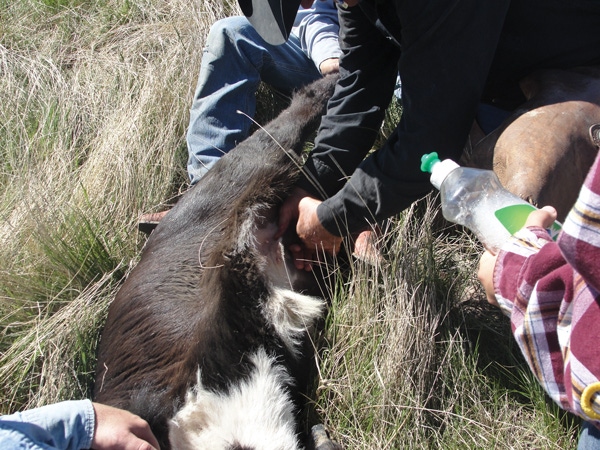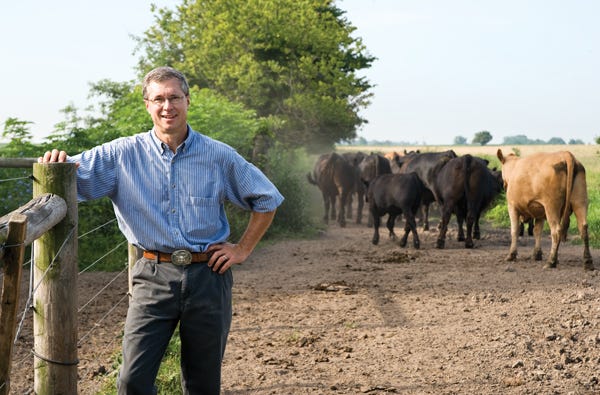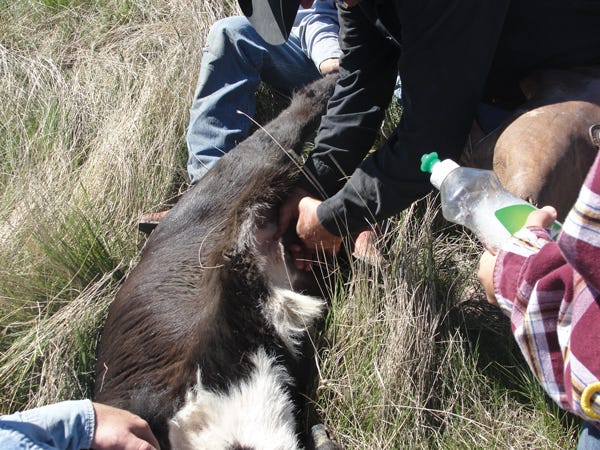What's The Best Time To Castrate Calves? Vets Agree The Earlier The Better
The key to effective and minimally painful castration is to do it early in life. Here’s a rundown on timing, tools and techniques.
July 4, 2014

While there are several ways to castrate calves and bulls, it’s less stressful to do all of them when calves are young. Randall Raymond, Simplot Livestock’s director of research and veterinary services, is a believer.
He says castration is a necessary procedure, not only for animal performance but also animal health and safety, as well as human safety. In his operation, Raymond says the procedure is performed “as young as we can have access to them. If not castrated at birth, the calves are castrated at branding, when they receive respiratory and clostridial vaccines.”
Cleanliness and technique are paramount, regardless of the method used. Daryl Meyer, a practicing DVM in North Platte, NE, recommends keeping tools in a bucket of water or disinfectant such as chlorhexidine. “It has the broadest spectrum of activity against a wide variety of pathogens and is also non-irritating to the tissues,” he says.
“Making sure the site [scrotum and surrounding area] is clean, the calf’s environment is clean, and tools are clean and in good working order are all crucial for success. The pen or environmental conditions are a factor when choosing methods. It’s hard to beat a green pasture that’s clean and dry,” he says.

“Just because we’ve done something a certain way for years doesn’t mean it’s the best way. The calf deserves the best we have.” --Mark Hilton, DVM
“Just because we’ve done something a certain way for years doesn’t mean it’s the best way. The calf deserves the best we have.” --Mark Hilton, DVM
Mark Hilton, a Purdue University DVM and regular BEEF magazine contributor, says cleanliness is so important that some producers postpone castrating at birth if the environment is muddy or dirty. “They write down the numbers of calves that didn’t get done, and cut them later. It’s not a good idea to castrate calves and have them lying in mud and manure,” he says.
And Raymond reminds those who band calves that tetanus is a risk anytime there is tissue without blood supply. “Tetanus can be part of a combination clostridial vaccine, or given separately. Anybody banding calves, or using the Burdizzo clamp and not removing the tissue, should give a tetanus vaccine,” he says.
Tools & techniques to castrate
Let’s discuss the various tools and techniques:
• Knife. Raymond says a sharp pocketknife and a very young calf are generally the least stressful combination for castration.
“Technique and sanitation are important, but using a sharp knife to remove a small testicle, pulling on the spermatic cord and scraping the blood vessels with the knife [to reduce bleeding] create minimal stress, and calves heal quickly. This is my preferred method in young calves,” he says.
• Banding. In very young calves, small elastrator bands called “cheerios” are another option. There’s no open wound as with a knife castration, so banding may be preferable if flies are present or the calves are in dirty conditions, Raymond says.
Care must be taken to ensure the band is placed above both testicles, around the spermatic cords. A properly applied and tightened band cuts off blood flow to the testicles, which will then atrophy and fall off.
“Some experience is needed to do it effectively and safely. There is some risk of entrapping more tissue in the band than appropriate, thus strangulating that tissue. It may be fat, but the worst-case scenario would be a piece of intestine that falls down through the inguinal ring,” Raymond says.

Make sure the calf’s scrotum and the surrounding area are clean, the calf’s environment is clean, and tools are clean and in good working order. The pen or environmental conditions are a factor when choosing the castration method. It’s hard to beat a green pasture that’s clean and dry. PHOTO BY MEG ENGLISH
Make sure the calf’s scrotum and the surrounding area are clean, the calf’s environment is clean, and tools are clean and in good working order. The pen or environmental conditions are a factor when choosing the castration method. It’s hard to beat a green pasture that’s clean and dry. PHOTO BY MEG ENGLISH
Using small bands on young calves, however, poses minimal risk as the band isn’t very big, the testicles are small and there’s not much extra tissue. “But people performing the procedure need to be aware of the risks,” he says. “If the calf is in pain afterward, or lies around for a longer time than you’d expect, a close check is needed.”
After applying the band, check to make sure both testicles are captured. “If a testicle is missed, the scrotum is shortened, and often the testicle is pushed up into the inguinal ring or body cavity, which makes it more difficult to find and remove later,” Raymond says. Clues that there might be a testicle remaining would be bull-like behavior or appearance and muscle formation.
Hilton says he’s castrated hundreds of older calves that had either one or both testicles retained. “It’s difficult because of scar tissue. I always give them tranquilizers and lay them down for this surgery,” he says.
• Emasculators. On larger calves cut with a knife, an emasculator is sometimes used to crush the cord following testicle removal. “With larger blood vessels and more blood supply to the testicles, there is more risk for bleeding. Emasculators are quick and effective, and help control blood flow,” Raymond says.
Adequate calf restraint is critical for safety. “The calf should be stretched out on the ground with ropes on front and hind legs, or in a chute where you can work without being kicked. The emasculator is bulky and needs to be held for a moment on the cord to make sure it’s crushed properly,” Raymond says.
• Newberry knife. Usable on larger calves, this tool is a combination of knife and pliers. The knife splits the side of the scrotum (both sides simultaneously), which allows rapid access to the testicle and spermatic cord. It also allows drainage, which is important on larger calves, Raymond says.
“The operator should be very familiar with the tool to use it properly, and it must be sharp to do the procedure quickly and effectively without undue pain. I recommend this tool when castrating calves at 400-600 lbs.,” he says.
• Henderson tool. Meyer says a cattle feeder, Lance Henderson, invented the tool because about 40% of the male calves he buys are intact. “This is frequently the case when buying male calves from Missouri, Arkansas and the Southeast,” Meyer says.
“The Henderson tool is a clamp that is placed above the testicle. Then it slides into a cordless drill, like a drill bit. Once you have the cord stripped down, you just clip this apparatus onto the cord and hit the drill button. It quickly spins and twists off and crushes the cord and blood vessels, sealing them off,” Meyer says.
The procedure eliminates bleeding when castrating large calves and bulls. “It’s fast and effective, but requires experience. It provides some of the same benefits as emasculators, but takes less time to crush or sever the spermatic cord,” Meyer says.
“The key to reducing complications in older animals is to really open up the bottom of the scrotum [for adequate drainage] when you cut them, and then use this tool,” he says. “If you’re really clean and give the animal long-acting antibiotics, infections will be rare.”
• Banding large calves. Several tools and methods exist for banding large calves, Raymond says. The advantage of banding larger calves in a feedlot is there are no open wound, though there are challenges.
“Banding creates an area of the body with no blood supply, which tetanus loves, so it’s critical that cattle receive a tetanus shot when banding — even when using an elastrator band on small calves. We don’t see tetanus as often in that age group [compared with large calves], but it is still a risk,” Raymond says.
Just as in small calves, operators must ensure both testicles are in the scrotum, and that the band is tight enough to completely block all blood supply, but not so tight that the band breaks or causes damage above the area that you want to fall off, Raymond explains. “If the band breaks or isn’t tight enough, there won’t be complete loss of blood supply to the testicle.”
Another challenge with banding is that large testicles swell and become even larger. After applying the band, making two small incisions at the bottom of the scrotum — one over each testicle — will allow fluids to drain. “This facilitates atrophy and shrinking of the testicles. In some cases, the calf may have to be restrained 2-3 days later for reopening of those drainage ports. If the testicles are very large, once they start to dry up we surgically remove the scrotum and testicles, just below the band,” Raymond says. Once the dead tissue is removed, the area heals more quickly, with less potential for additional problems.
“If done correctly and blood supply is completely eliminated, banding can be a fast, effective and clean method to castrate big calves. We’ve done trials investigating banding’s effects on calves, such as the time it takes for them to get back on feed, vs. cutting them and using an emasculator. The two groups had similar results for time back on feed,” Raymond says.
A few years ago, he says he’d have argued that banding caused more sustained pain in big calves than castration with a sharp knife. “More recent data suggests this probably isn’t the case. Once the blood [and nerve] supply to the scrotum and testicles is eliminated, nerve function is compromised and pain sensation in that area is gone. Feed intake research supports this conclusion. If done correctly, the time back to full feed is similar for both methods,” he says.
• Burdizzo clamp. The Burdizzo clamp is placed above the testicles in the scrotum; when pressure is applied, the spermatic cord is crushed while the scrotum is left intact. The effect, as well as advantages and disadvantages, is similar to banding.
Crushing the cord removes the blood supply, and the testicles die and shrink within the scrotum. Over time, the body resorbs the atrophied tissue.
“The advantage is no open wound; the disadvantages are the challenges of technique and making sure both cords are crushed completely. Not being able to see the testicle removed or sloughed off, you don’t really know if both testicles are properly affected,” Raymond says.
Pain management
Management of pain and stress are important with surgical procedures in cattle. It also deserves more attention within the industry, says Randall Raymond, Simplot Livestock’s director of research and veterinary services.
“As stewards of these animals and their well-being, this is something we must consider. The problem is we don’t have effective and legal pharmacologic tools to manage pain, so we’re left trying to strategize timing and methods of castration to minimize pain and stress to the animal.”
Hilton says the beef industry needs to think about humane considerations. “Just because we’ve done something a certain way for years doesn’t mean it’s the best way. I’ve been a veterinarian for 30 years, and I change how I do things every year. I try to learn better ways. The calf deserves the best we have,” he says.
The Canadian livestock industry is considering requiring pain medication when castrating older animals. “As we get more research on this, our industry in the U.S. may go this route, too, utilizing pain management, similar to what we do when castrating a horse,” Hilton says.
Daniel Thomson, a Kansas State University professor of production medicine and epidemiology, says castration, dehorning, branding, etc., are necessary and routine husbandry procedures.
“We must make sure we’re current regarding the best techniques and opportunities for preventing pain. The main thing we can do in terms of minimizing pain is to do it as early as possible in the calf’s life,” he explains.
Technologies like immunocastration offer promise for the future, but more reliability is needed. There are also consumer perception factors to overcome with use of that technology. “With the methods in use today, our best and most humane option is to castrate calves as young as possible,” Thomson says.
David Rethorst, a Kansas State University DVM, concurs. “We need to encourage producers to castrate early — preferably at birth, but no later than 2-3 months of age. We could help ourselves a lot by doing that,” he says.
Other trending stories online:
Are You Deworming Your Cows At The Right Time?
Tips For Diagnosing And Treating Coccidiosis In Calves
Why You Need To Consider Hedging In 2014
Virtual Test Drive: Kubota RTV Utility Vehicle
What Is The Future Of Genetic Evaluation?
You May Also Like


.png?width=300&auto=webp&quality=80&disable=upscale)
